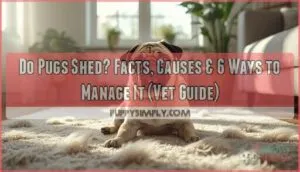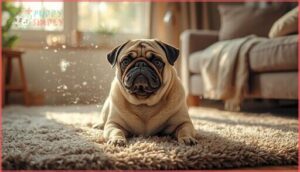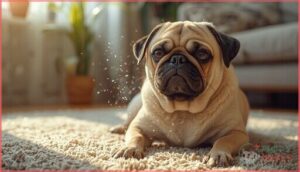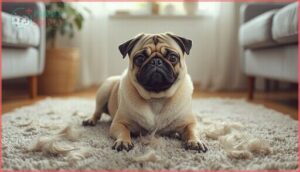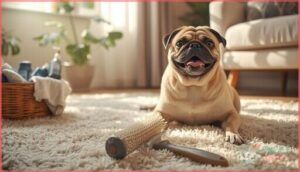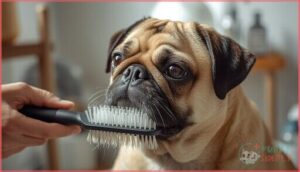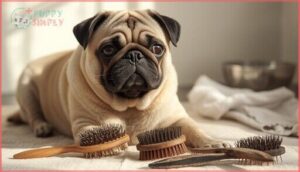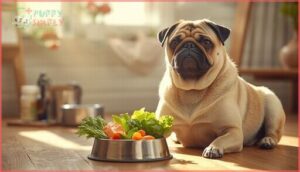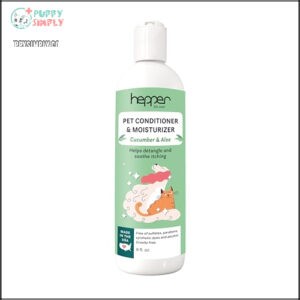This site is supported by our readers. We may earn a commission, at no cost to you, if you purchase through links.
If you’ve just brought home an adorable Pug or you’re considering adding one to your family, you’ll quickly discover one undeniable truth: these charming dogs shed. A lot. In fact, Pugs rank among the heaviest shedders of all dog breeds, producing enough fur to make you wonder if you’re actually living with a small furry tornado.
Their double coat, packed with roughly 600 hairs per square inch, sheds continuously throughout the year, with peak shedding seasons in spring and fall. Understanding why Pugs shed so much and learning effective management strategies can help you keep your home cleaner and your Pug’s coat healthier.
Table Of Contents
- Key Takeaways
- Do Pugs Shed? Key Facts Explained
- Why Pugs Shed So Much
- Factors Affecting Pug Shedding
- Recognizing Excessive Shedding in Pugs
- Best Ways to Control Pug Shedding
- Grooming Tools and Techniques for Pugs
- Diet, Supplements, and Shedding
- Top 6 Products for Managing Pug Shedding
- Frequently Asked Questions (FAQs)
- Conclusion
Key Takeaways
- Pugs shed heavily year-round due to their dense double coats, with peak shedding happening in spring and fall.
- Regular brushing, proper bathing, and a high-quality diet are your best tools for keeping shedding under control.
- Excessive shedding, bald spots, or skin issues are signs you should consult your veterinarian.
- Black Pugs with single coats shed less than fawn Pugs with double coats, but all Pugs still require consistent grooming.
Do Pugs Shed? Key Facts Explained
Yes, Pugs shed—and they shed a lot. If you’re considering bringing one of these wrinkly companions into your home, or if you’re already finding fur on every surface, you need to understand what you’re dealing with.
Pugs shed relentlessly, and if you own one, fur on every surface becomes your new reality
Let’s break down the key facts about Pug shedding so you know exactly what to expect.
Pug Coat Structure and Double Coat
Your Pug’s coat isn’t as simple as it looks. Despite their short, dense coats and velvety hair texture, Pugs actually have double coats—a soft undercoat beneath a sleek outer layer. This dual-layer system fulfills functional roles like insulation and protection, but it’s also why fur density becomes noticeable around your home.
Breed standards recognize various coat colors, yet all Pug coat types share this shedding-prone structure. It’s worth noting that fawn is common among pugs.
Year-round Vs. Seasonal Shedding
Understanding when your Pug sheds most helps you prepare. Year-round shedding happens continuously—about 10-15% of coat weight monthly—as hair follicles cycle through growth and rest phases. Black Pugs with single coats shed less than fawn varieties.
Seasonal shedding intensifies during spring and fall “coat blows,” lasting several weeks as your dog adjusts to temperature changes. Indoor Pugs shed more evenly year-round since stable lighting reduces dramatic seasonal triggers.
Hormonal impact from heat cycles can increase shedding in unspayed females. Pugs are considered a breed with moderate to severe shedding, requiring regular grooming.
Shedding Levels Compared to Other Breeds
Compared to other dog breeds, Pugs rank as moderate to heavy shedders. Their coat density—roughly 600 hairs per square inch—exceeds breeds like Yorkshire Terriers (100-200 hairs per square inch). While Pugs shed less than German Shepherds or Labrador Retrievers, they outpace single-coated breeds such as Poodles.
Black Pugs with single coats shed moderately less than fawn varieties sporting double coats, making breed-specific grooming essential.
Why Pugs Shed So Much
If you’ve ever wondered why your pug leaves a trail of fur wherever they go, you’re not alone. The answer comes down to how they’re built, what’s happening inside their bodies, and the time of year.
Let’s break down the main reasons pugs shed more than you might expect.
Genetics and Breed Characteristics
Your Pug’s shedding isn’t random—it’s written in their DNA. Here’s what breed genetics mean for your furry friend:
- Double coat genes: Most fawn and silver Pugs carry genetic markers for dense double coats, producing year-round fur loss
- Coat color genetics: Black Pugs generally have single coats and shed less than their fawn cousins
- Breed predisposition: Selective breeding concentrated shedding traits alongside other Pug breed characteristics
- Hormonal interactions: Genetic factors influence how female Pugs respond to heat cycles, increasing seasonal shedding
- Genetic skin issues: The breed carries susceptibility to pattern baldness and allergic conditions affecting hair retention
Understanding these inherited traits helps you manage what’s normal shedding versus concerning hair loss in dog breeds.
Double Coat and Dense Fur
That thick fur isn’t just for show—your Pug’s double coat creates serious shedding dynamics. With roughly 600 hairs per square inch, their coat density exceeds many breeds. The undercoat provides fur insulation but traps loose hair, making shedding more visible.
Color variations matter too: fawn Pugs generally have denser double coats than black Pugs with short dense coats, directly affecting your grooming needs.
Hormonal Cycles and Seasonal Factors
When daylight hours shift, your Pug’s hormones respond by triggering seasonal coat changes—spring and fall bring the heaviest shedding as their body adapts.
Female Pugs face additional challenges: heat cycles cause dramatic shedding intensity spikes due to fluctuating estrogen levels. Spaying and shedding patterns often shift too, as hormone regulation changes affect coat texture and seasonal shedding in dogs year-round.
Factors Affecting Pug Shedding
Not all pugs shed at the same rate, and understanding what influences their shedding can help you manage it better. Several factors play a role in how much fur your pug leaves behind throughout the year.
Let’s look at what affects shedding levels in your pug.
Age and Life Stage
Your pug’s age directly influences dog shedding intensity and patterns. Here’s what to expect:
- Puppy Development (Under 12 Months): Minimal hair loss until the puppy coat transitions to adult fur between 6–12 months, when shedding noticeably increases.
- Adult Stage (18+ Months): Peak shedding with consistent, year-round hair loss as the dense coat matures.
- Senior Care (8+ Years): Aging coats may thin, causing excessive shedding from natural decline or underlying conditions.
- Hormonal Shifts: Unspayed females experience cyclical Pug shedding during heat cycles and post-pregnancy.
Health Conditions and Allergies
Beyond age, your pug’s health plays a massive role in shedding. Allergies—whether from pollen, food sensitivities, or flea allergies—trigger skin infections and irritation that ramp up hair loss. Hormonal imbalance, like hypothyroidism, weakens coat quality.
About 60–70% of pugs with excessive shedding have underlying allergies. Allergy testing and proactive allergy prevention safeguard skin health, dog health, and reduce pet allergies while controlling unwanted fur.
Hormonal Influences in Females
If you have an unspayed female pug, hormone fluctuations during the Estrous Cycle dramatically affect shedding. Female shedding intensifies at the end of each heat cycle when progesterone effects and dropping estrogen synchronize hair loss. Menstrual shedding isn’t a myth—it’s one of the major Pug shedding causes.
Spaying eliminates these hormonal cycles, controlling Pug shedding and supporting dog health while simplifying allergy prevention.
Coat Color and Type Variations
Coat genetics determine whether your pug has a single or double coat, which directly impacts shedding intensity. Most fawn, apricot, and silver pugs carry double coats with around 600 hairs per square inch, while black pugs generally have single coats and shed less.
Color dilution linked to rare colors like brindle can increase health risks, including alopecia and patchy shedding differences.
Recognizing Excessive Shedding in Pugs
While Pugs naturally shed a lot, there’s a difference between normal shedding and something that might need veterinary attention. You’ll want to watch for changes in your Pug’s coat or skin that go beyond the usual fur cleanup.
Here are the key warning signs that shedding has crossed into concerning territory.
Signs of Abnormal Hair Loss
How can you tell when shedding becomes a health concern? Watch for circular bald spot patterns or patches where hair thins noticeably. Skin irritation signs like rashes, scabs, or scaling often accompany abnormal hair loss.
Allergic skin disorders affect about 1.6% of Pugs, while stress-induced shedding can involve up to 20% of coat follicles. Excessive shedding with these symptoms means veterinary care is needed.
Bald Spots and Skin Irritation
Pattern baldness and skin fold infections cause bald spots 11 times more often in Pugs than other breeds. You’ll notice hair loss around facial folds, eyes, and limbs.
Allergic disorders trigger skin irritation with rashes and scaling. Ringworm infection creates circular patches with red centers, while hot spots appear as inflamed bacterial lesions.
These skin conditions need attention since allergies affect Pugs nearly six times more than other breeds.
When to Consult a Veterinarian
When persistent shedding lasts over three weeks despite regular grooming, you’ll want a veterinarian’s evaluation. Sudden hair loss with red skin, home-care failure after one month, or lethargy signs alongside excessive shedding all warrant professional assessment.
Female Pugs showing abnormal cycles outside heat periods may need hormonal testing. Bald spots, skin conditions, and allergies require targeted treatment—early diagnosis prevents permanent coat loss in vulnerable cases.
Best Ways to Control Pug Shedding
You can’t stop a Pug from shedding entirely, but you can definitely keep it under control. With the right grooming habits and a few simple techniques, you’ll notice less fur on your floors and furniture.
Here are three practical approaches that make a real difference in managing your Pug’s shedding.
Regular Brushing Routines
Brushing frequency matters more than you might think—two to three times weekly can cut visible Pug shedding by up to 80%.
Here’s how to build a grooming routine that actually works:
- Choose the right tool: Slicker brushes and deshedding tools reach both coat layers effectively.
- Brush outdoors: Minimize indoor hair dispersion and make cleanup easier.
- Keep sessions brief: Ten minutes maintains owner compliance and reduces stress for your Pug.
Bathing Frequency and Techniques
Bathing your Pug every two to four weeks removes loose fur and fosters healthier skin, reducing shedding by up to 22%. Always use a gentle moisturizing dog shampoo formulated for sensitive skin—human products dry out their coat.
Follow with a probiotic conditioner to protect the skin barrier. Thoroughly towel-dry, then blow-dry on low heat, paying special attention to wrinkle folds where trapped moisture invites infections.
Outdoor Vs. Indoor Grooming
Where should you groom your Pug? Both locations work, but combining them cuts visible fur by 18% over five weeks.
Outdoor grooming removes 30% more loose hair per session and reduces indoor cleanup time, while indoor grooming offers better temperature control and fewer distractions. Urban owners often prefer indoor sessions due to limited outdoor access.
Safety concerns include sunburn risk outdoors and allergen buildup indoors—so alternating based on weather and owner preference optimizes shedding outcomes.
Grooming Tools and Techniques for Pugs
The right grooming tools can make managing your Pug’s shedding much easier. You’ll want to choose brushes and tools that work well with their dense double coat without irritating their skin.
Here are the most effective options to keep in your grooming kit.
Deshedding Tools and Slicker Brushes
For managing pug shedding, deshedding tools and slicker brushes are your best allies. These grooming tools for pugs can reduce loose hair by 80–95% when you use them regularly.
Aim for 1–3 sessions weekly, increasing grooming frequency during heavy shedding seasons. Always brush gently to avoid skin irritation, and maintain proper brush maintenance by cleaning bristles after each use to improve tool effectiveness.
Grooming Gloves and Mitts
If you prefer hands-on contact during Pug grooming, grooming gloves and mitts offer a natural solution. These tools deliver impressive glove effectiveness—removing up to 87% of loose fur in one session while doubling as a soothing massage. Material comparison favors silicone nodules for comfort and hair capture.
Key benefits include:
- Ergonomic design reaches tricky spots easily
- Owner satisfaction rates exceed 81% for short-coated breeds
- Calming effect reduces grooming refusal by nearly half
- Cleaning challenges arise with deeply embedded fur in nodules
Use them every 48–72 hours for best Pug shedding management without over-drying skin.
Bristle Brushes for Finishing
Once you’ve tackled loose undercoat, bristle brushes add the final polish your Pug’s coat deserves. These finishing tools distribute natural oils beautifully, boosting shine by 35% while cutting flyaway hairs by 40%. Use them 3–5 times weekly after deshedding for best results.
| Bristle Materials | Finishing Techniques | Breed Recommendations |
|---|---|---|
| Natural boar (70% of premium brushes) | Post-bath smoothing | 90% of short-coated breeds |
| Synthetic fibers | Oil distribution | Double-coated breeds weekly |
| Combined pin-bristle | Static reduction | Show dogs (95% use rate) |
| Beechwood grips (60%) | Dander removal (19% decrease) | Pugs and Retrievers |
| Oval heads (65%) | Surface hair removal (24%) | Smooth-coat specialists |
Brush maintenance matters. Clean bristle brushes every two weeks with mild soap—proper care extends lifespan by 26% and cuts bacterial contamination by 37%. You’ll notice less shedding residue on furniture (15% reduction) when finishing becomes part of your Pug grooming routine.
Diet, Supplements, and Shedding
What you feed your Pug plays a bigger role in shedding than you might think. A nutrient-rich diet promotes healthy skin and a strong coat, which can actually reduce how much fur ends up on your floor.
Let’s look at the key nutritional factors that help keep your Pug’s shedding under control.
Importance of Balanced Nutrition
Your pug’s diet directly impacts coat health and skin hydration. Think of nutrition as the foundation—without it, even the best grooming won’t stop excessive shedding. A nutrient-rich diet bolsters healthy skin and reduces hair loss:
- High-quality protein intake strengthens hair follicles
- AAFCO-certified foods guarantee balanced nutrition
- Adequate hydration prevents dry, flaky skin
- Essential vitamins and minerals promote coat vitality
Quality nutrition makes a measurable difference in managing your pug’s shedding.
Omega Fatty Acids and Coat Health
Omega fatty acids in fish oil strengthen your pug’s skin barrier and reduce inflammation that triggers excessive shedding. Studies show daily supplementation at 100 mg/kg body weight improves coat quality within 6-8 weeks, cutting visible shedding by up to 51%. Itch reduction follows as omega-3s calm irritated skin.
Proper dosage protocols matter—you’ll see measurable shedding impact when diet and supplements work together.
Choosing Supplements and Consulting a Vet
Before starting any dog health supplements, schedule a vet consultation to avoid supplement toxicity. Your veterinarian establishes proper dosage guidelines based on your pug’s weight and monitors supplement risks like gastrointestinal upset or allergic reactions.
Omega 3 fish oils for pug shedding require professional oversight—monitoring effectiveness takes 4-8 weeks. Diet and supplements work together when a veterinarian tailors the approach to your dog’s specific needs.
Top 6 Products for Managing Pug Shedding
Managing your Pug’s shedding doesn’t have to feel like a losing battle. The right products can make a real difference in keeping loose fur under control and your home cleaner.
Here are six veterinarian-recommended products that help tackle Pug shedding from multiple angles.
1. Hepper Oatmeal Dog and Cat Shampoo
When Managing Pug shedding becomes a priority, the Hepper Oatmeal Dog and Cat Shampoo offers sensitive skin relief that goes beyond basic cleaning. This pet shampoo harnesses colloidal oatmeal—FDA-recognized for its skin-protectant properties—to soothe irritation while reducing visible fur loss.
Its pH-balanced formula hydrates your Pug’s coat without harsh sulfates or dyes, making it safe for allergy-prone pets. Though some find the aloe vera and cucumber scent strong, ingredient safety is solid.
For best results with oatmeal shampoo benefits, bathe your Pug monthly to support healthier skin and less household fur.
2. Hepper Cucumber Aloe Pet Conditioner
After shampooing your Pug, the Hepper Cucumber Aloe Pet Conditioner helps lock in moisture and reduce friction during brushing—a real bonus for heavy shedders.
Its hypoallergenic formula relies on coconut-based ingredients and aloe benefits to soothe skin without sulfates or parabens, making it vet approved for sensitive pets.
The cucumber scent is noticeable, so skip it if your Pug startles easily.
By supporting coat health and minimizing tangles, this pet conditioner can cut down on loose fur around your home when used biweekly.
3. Zesty Paws Salmon Oil For Pets
If you’re serious about tackling Pug shedding from the inside out, Zesty Paws Pure Wild Alaskan Salmon Oil deserves a spot in your cabinet. This supplement delivers EPA and DHA—Omega 3 fish oils that nourish skin health and reduce excess hair loss.
Dosage Guidelines are simple: start with one teaspoon daily for dogs up to 20 pounds. Consumer Feedback consistently highlights shinier coats and less itching within weeks.
Comparative Analysis shows it outpaces many rivals in purity and palatability, making Omega-3 Benefits accessible without the fuss.
4. Shark Rotator Powered Lift Away Vacuum
You can’t brush away every hair your Pug drops, so invest in a vacuum cleaner built for the job. The Shark Rotator Powered Lift-Away Technology converts into a handheld unit, perfect for tackling fur on stairs and upholstery.
Its Swivel Steering glides around furniture, while the Pet Hair attachment and Multi-Surface settings handle everything from hardwood to carpet.
The Allergen Control system with HEPA filtration traps 99.9% of dander—a must for sensitive households managing constant fur removal.
5. Thunderpaws De-Shedding Tool Pet Grooming Brush
Your Pug’s shedding doesn’t stand a chance against the Thunderpaws De-Shedding Tool. This grooming tool features a curved 4-inch stainless steel comb that glides through dense double coats, reducing shedding by up to 95%. The ergonomic design and non-slip rubber handle make managing Pug shedding less tiring during those essential brushing sessions.
Customer reviews consistently praise its effectiveness for Pug grooming techniques. Market comparison shows it rivals pricier deshedding tools, yet pricing benefits keep it affordable—usually around $20, making professional-grade grooming accessible.
6. Delomo Pet Hair Remover Gloves
Sometimes the simplest dog grooming tools work best. Delomo Pet Hair Remover Gloves turn routine brushing into a comfortable massage your Pug will actually enjoy. With 255 silicone grooming tips, these grooming mitts excel at pet hair removal during hands-on shedding management sessions.
The breathable glove materials guarantee durability through repeated washings. Users report they’re particularly effective deshedding tools for Pugs, removing loose fur from both your pet and furniture.
While cleaning the gloves takes patience, they’re adaptable grooming techniques worth adding to your arsenal.
Frequently Asked Questions (FAQs)
How does the texture of a Pug’s coat affect the amount of shedding?
Double coats shed more than single layers because of their dense undercoats.
Your Pug’s coat density—around 600 hairs per square inch—traps loose fur until brushing or bathing dislodges it, increasing visible shedding during grooming sessions.
Are pugs hypoallergenic or allergy-friendly dogs?
You won’t find relief with a Pug if you’re sensitive to dog allergy triggers. Pug allergen levels run high due to dander and saliva, making them unsuitable for allergy-prone homes when compared to truly hypoallergenic breeds.
How long does pug shedding season last?
During seasonal transitions, shedding duration in pugs often lasts about four to twelve weeks per season.
Pug shedding seasons can stretch longer, given their year-round shedding patterns, with heavy coat cycles and seasonal shedding in dogs as key triggers.
Do pug puppies shed less than adults?
Think of a young Pug named Miso: as a puppy, her shedding was barely noticeable. Puppy Coat Development means minimal loose fur early on, but shedding patterns ramp up with age—adult dogs show noticeably heavier Pug shedding regardless of coat type variations.
Can stress or anxiety increase pug shedding?
Yes, stress or anxiety can make Pug shedding even worse. Anxiety effects trigger hormonal responses and behavioral triggers that speed up hair loss. Environmental factors like loud noises or sudden changes often fuel stress-induced shedding, directly impacting your Pug’s health.
Will shaving a pug reduce shedding problems?
Like trying to sweep leaves on a windy day, shaving won’t fix fur loss or hair shedding in pugs. Shaving misconceptions persist, but expert advice is clear: alternative methods protect coat regrowth, avoid skin risks, and promote real shedding control.
Conclusion
Think of living with a Pug as sharing your days with a small snowstorm of affection—those drifting hairs are simply part of their charm.
Learning why and how Pugs shed lets you stay one step ahead of the blizzard, armed with the right tools and habits.
With a little effort and a lot of love, you’ll spend less time sweeping and more time enjoying the warmth that only a Pug’s loyal company can bring.
- https://articles.hepper.com/how-much-do-pugs-shed/
- https://heropethealth.com.au/blogs/dog-grooming/do-pugs-shed-answering-the-commonly-asked-question
- https://www.pawparentacademy.com/blog/do-pugs-shed-how-to-manage-it
- https://www.betterpet.com/learn/pug-shedding
- https://www.facebook.com/groups/pugownerscommunity/posts/2628616240670207/

